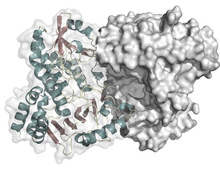Styrene monooxygenase
| Styrene monooxygenase ( Pseudomonas putida ) | ||
|---|---|---|
| [[File:| 250x300px | Styrene monooxygenase ( Pseudomonas putida )]] | ||
| 3D structure of a styrene monooxygenase according to PDB 3ihm | ||
| Mass / length primary structure | 430 amino acids | |
| Secondary to quaternary structure | Dimer | |
| Cofactor | FADH 2 | |
| Identifier | ||
| Gene name (s) | StyA | |
| External IDs | ||
| Enzyme classification | ||
| EC, category | 1.14.14.11 , monooxygenase | |
| Response type | Epoxidation | |
| Substrate | Styrene + FADH 2 + O 2 | |
| Products | ( S ) -styrene oxide + FAD + H 2 O | |
| Occurrence | ||
| Parent taxon | some bacteria | |
Styrene monooxygenase (SMO) is an enzyme found in bacteria . It catalyzes the endothermic chemical reaction
- Styrene + FADH 2 + O 2 ↔ ( S ) -2-phenyloxirane + FAD + H 2 O
as the first step in the aerobic styrene breakdown pathway of bacteria . The product 2-phenyloxirane ( styrene oxide ) can be isomerized to phenylacetaldehyde by a styrene oxide isomerase (SOI) . The latter is further oxidized by a phenylacetaldehyde dehydrogenase ( EC 1.2.1.39 ) to phenylacetic acid , a key intermediate .
According to the EC number , the enzyme (SMO) belongs to the group of oxidoreductases and is dependent on the cofactor FAD , so that it was classified as an external flavoprotein monooxygenase (subgroup: type E). It forms a two-component system with a reductase (StyB, StyA2B). The reductase only uses NADH to reduce FAD, which is then transferred to the oxygenase (StyA, StyA1). Two types of the enzyme have been documented so far: StyA / StyB (designated as E1), first described in Pseudomonas species, and StyA1 / StyA2B (designated as E2), first described in actinobacteria . The E1 type seems to be more common in nature and consists of a single monooxygenase (StyA) supported by a single reductase (StyB). The E2 type is composed differently, however. It consists of a main monooxygenase (StyA1) and a fusion protein of monooxygenase and reductase (StyA2B). The latter is the source of reduced FAD (reductase) and also has some secondary activity as an oxygenase. So far, all styrene monooxygenases carry out an enantioselective epoxidation of styrene and chemically analogous compounds, which makes them interesting for biotechnological applications.
Individual evidence
- ^ Mooney, A., PG Ward, and KE O'Connor. 2006. Microbial degradation of styrene: biochemistry, molecular genetics, and perspectives for biotechnological applications . Appl. Microbiol. Biotechnol. 72: 1-10. PMID 16823552
- ↑ a b Montersino, S., D. Carpenter, GT Gassner, and WJH van Berkel. 2011. Catalytic and structural features of flavoprotein hydroxylases and epoxidases . Adv. Synth. Catal. 353: 2301-2319.
- ↑ van Berkel, WJH, NM Kamerbeek, and MW Fraaije. 2006. Flavoprotein monooxygenases, a diverse class of oxidative biocatalysts . J. Biotechnol. 124: 670-689. PMID 16712999
